AI Tools 101
Softr Review: Build Apps Fast Without Writing a Single Line
Unite.AI is committed to rigorous editorial standards. We may receive compensation when you click on links to products we review. Please view our affiliate disclosure.
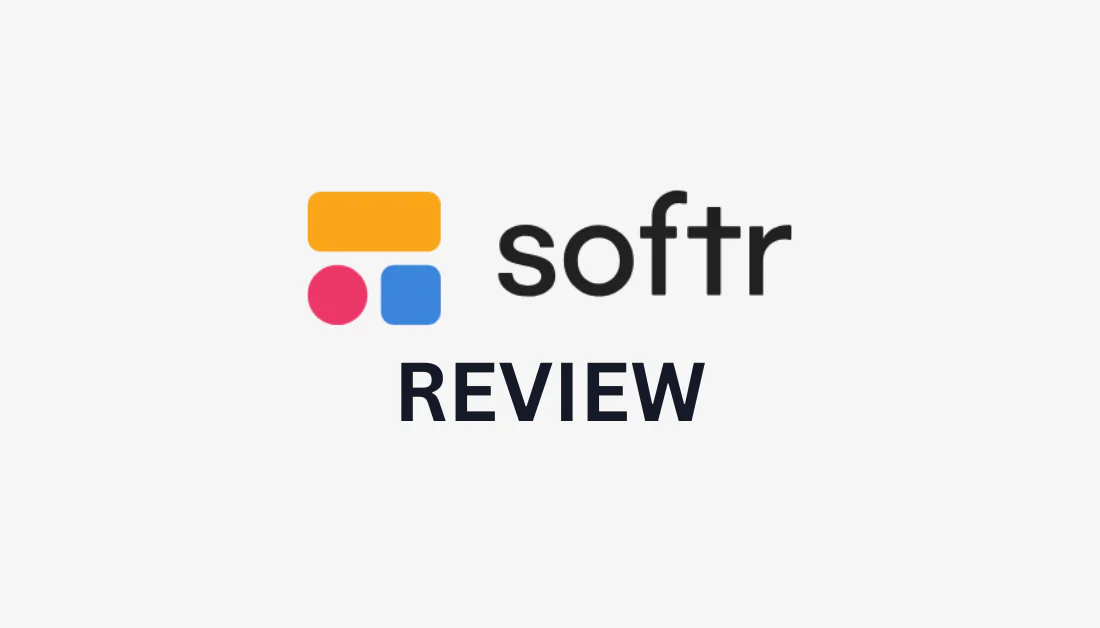
Have you ever had an idea for an app but felt stuck because you don’t know how to code?
I recently tried Softr, and I couldn’t believe how easy it was to turn my idea into a functioning app in minutes without writing a single line of code. Softr took my data from Airtable and Google Sheets and turned it into an app in minutes.
In this Softr review, I’ll discuss the pros and cons, what it is, who it’s best for, and its key features. Then, I’ll show you how I used Softr to create and publish an app for an internal tool in minutes.
I’ll finish the article by comparing Softr with my top three alternatives (Base44, Draftbit, and AppMySite). By the end, you’ll know if Softr is right for you!
Whether you want to create a client portal, an internal tool, or a membership site, Softr makes the process fast, intuitive, and fun.
Verdict
Softr is a no-code tool that helps you build apps fast with drag-and-drop features, database integrations, and affordable pricing. However, it has limits in scalability, customization, and mobile support, so it’s not the best fit for complex or regulated projects.
Pros and Cons
- Easy drag-and-drop builder with no coding required
- Excellent Airtable, Google Sheets, and database integration
- 90+ pre-built templates and blocks for fast app launches
- Free plan with affordable pricing options
- Built-in SEO tools and fast performance
- Supports Stripe, PayPal, and Gumroad payments
- Limited scalability for large apps or many users
- Dependent on external databases, which can cause delays and limit control
- Restricted customization due to pre-built blocks
- No native iOS or Android apps, only PWAs
- Lacks advanced security features for regulated industries
What is Softr?
Softr is a no-code platform for building web applications (client portals, internal tools, directories, and membership platforms) without writing code. What sets it apart is how seamlessly it connects to your existing data sources, including Airtable, Google Sheets, Supabase, etc.
Compared to other no-code tools, Softr hits this sweet spot where you can build real business applications without losing your mind. The learning curve is manageable, and you’re not spending hours trying to figure out complex workflows like you do with some other platforms.
What I love about Softr’s approach is how they’ve designed it around common business needs. You’re not starting from a blank canvas, wondering what to build.
Instead, you’re choosing from proven use cases like membership sites, directories, or internal tools. You can build everything from a simple team directory to a full membership community with paid subscriptions.
With Softr, you can build some pretty sophisticated applications: inventory management systems, project management tools, and even basic e-commerce platforms. The key is understanding that it’s database-driven, so if you can organize your data well in Airtable or Google Sheets, Softr can turn it into something powerful.
Who is Softr Best For?
Here are the types of people who get the most out of using Softr:
- Small to medium businesses and startups can use Softr to create internal tools, client portals, CRMs, dashboards, and member-only sites without hiring developers.
- App builders can use Softr to launch apps quickly with templates and blocks.
- Entrepreneurs and freelancers can use Softr to easily build apps or business tools affordably.
- Marketing agencies can use Softr for client reporting dashboards.
- Consultants can use Softr to build resource libraries.
- Those with existing databases can use Softr to turn Airtable, Google Sheets, and other data sources into functional apps.
- Anyone can use Softr to build apps without coding, thanks to its drag-and-drop interface.
Softr Key Features
Here are Softr’s features:
- No-code Builder: Create apps, portals, and directories with drag-and-drop blocks.
- Database Connections: Connect to Airtable, Google Sheets, Supabase, or SQL for live data.
- Templates: 100+ responsive templates for projects.
- User Access: Built-in login and permissions for secure apps.
- Automation: Connect with tools like Zapier or Make to streamline tasks.
- Payments: Accept payments with Stripe, PayPal, or Gumroad.
- Branding: Add your own domain and customize the look.
- PWA Support: Turn apps into installable web apps for all devices.
- Security: SOC 2 compliance, SSO, and secure storage.
- Integrations: Connect with 30+ tools and APIs.
- Responsive Design: Works smoothly on desktop, tablet, and mobile.
How to Use Softr
Here’s how I used Softr to create and publish an app:
- Create a Softr Account
- Create Your App
- Add a Prompt
- Preview & Generate
- Add Blocks
- Connect Data
- Choose the Data Source
- Add Pages & Adjust the Theme
- Preview the App
- Publish
Step 1: Create a Softr Account
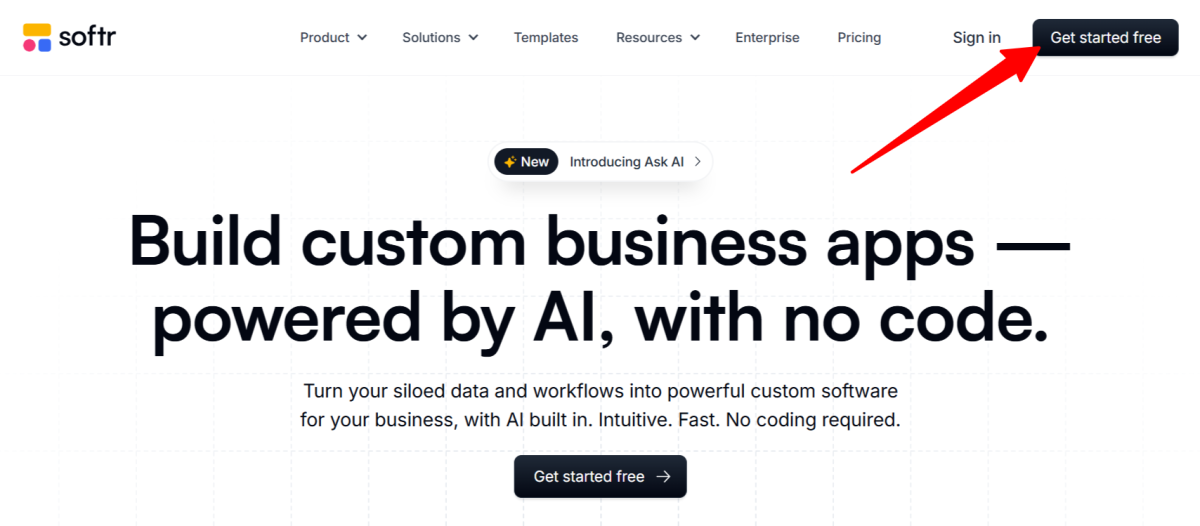
I started by going to softr.io and selecting “Get Started Free.”
Step 2: Create Your App
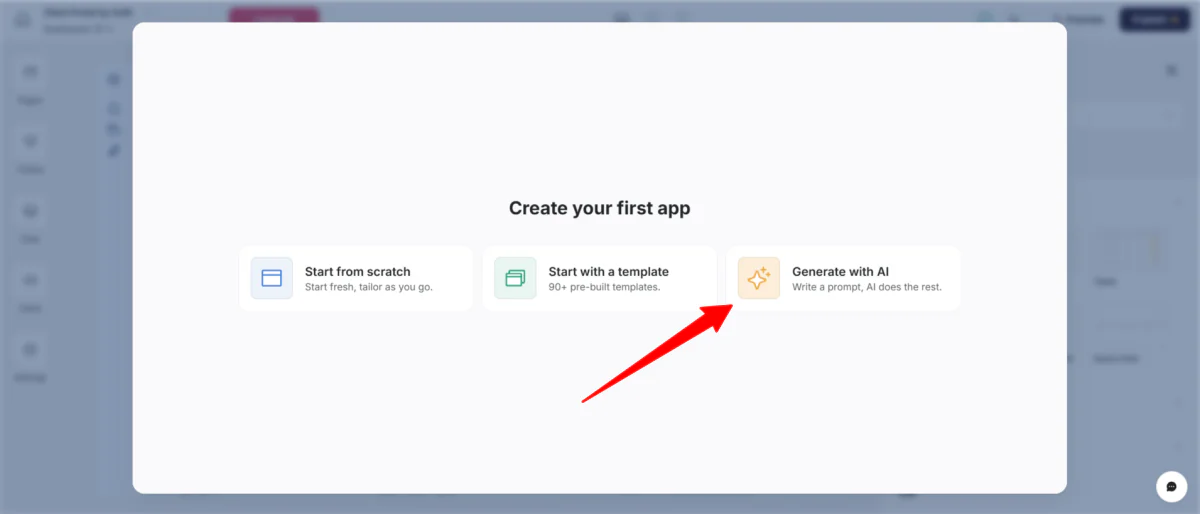
After creating an account and answering a few questions to personalize my experience, Softr asked me how I wanted to create my first app:
- From scratch
- With a template
- With AI
I was most curious about creating an app with AI, so I chose “Generate with AI.”
Step 3: Add a Prompt
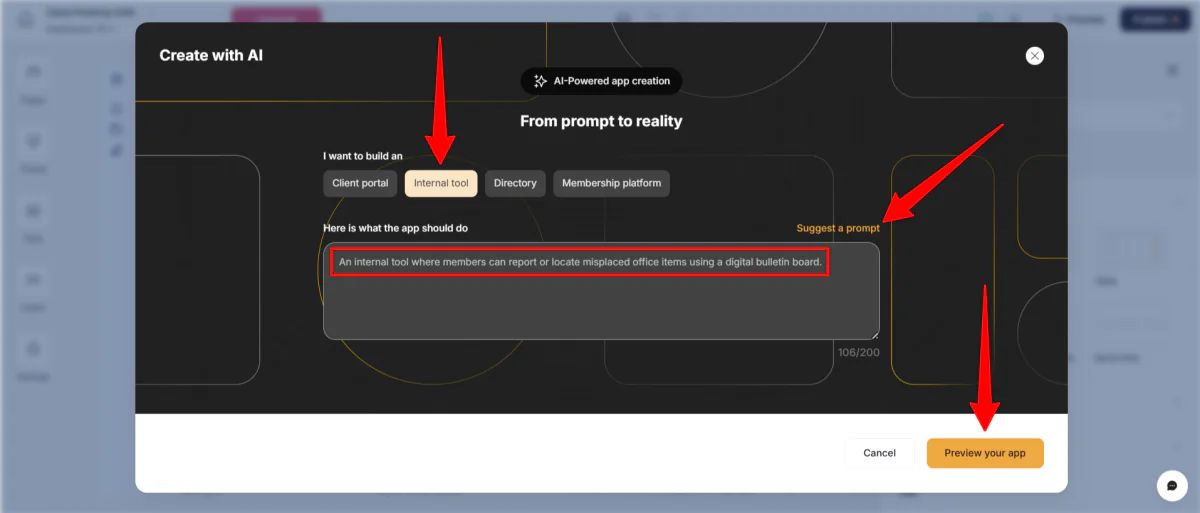
Next, Softr asked me what I wanted to build:
- Client portal
- Internal tool
- Directory
- Membership platform
I chose “Internal tool” and selected “Suggest a prompt.” Here’s what Softr came up with:
“An internal tool where members can report or locate misplaced office items using a digital bulletin board.”
Once my prompt was added, I selected “Preview App.”
Step 4: Preview & Generate
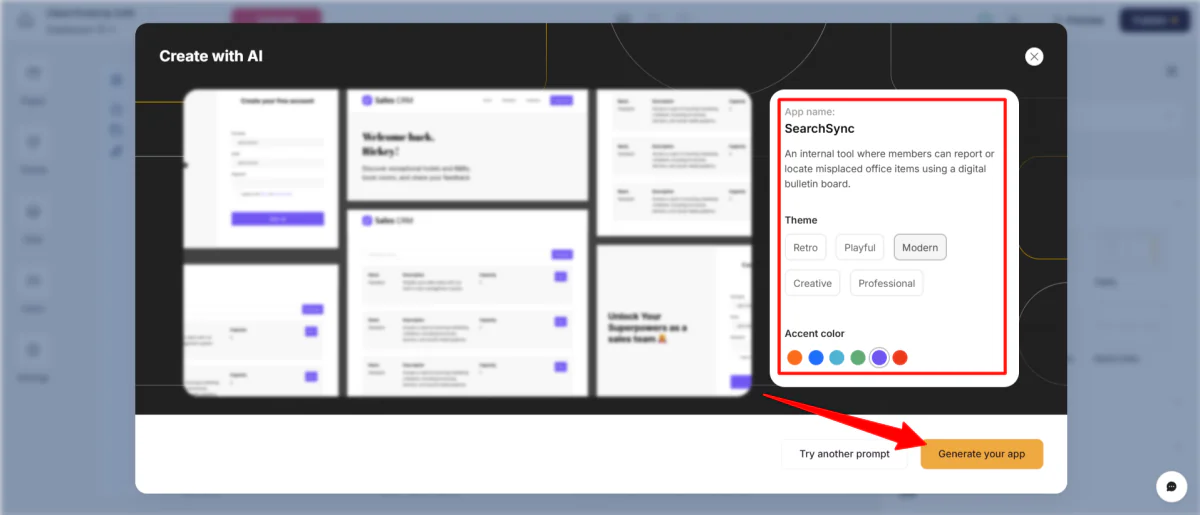
Seconds later, Softr generated a preview of my app. It generated an app name and description.
I chose the theme and accent color, then clicked “Generate your app.”
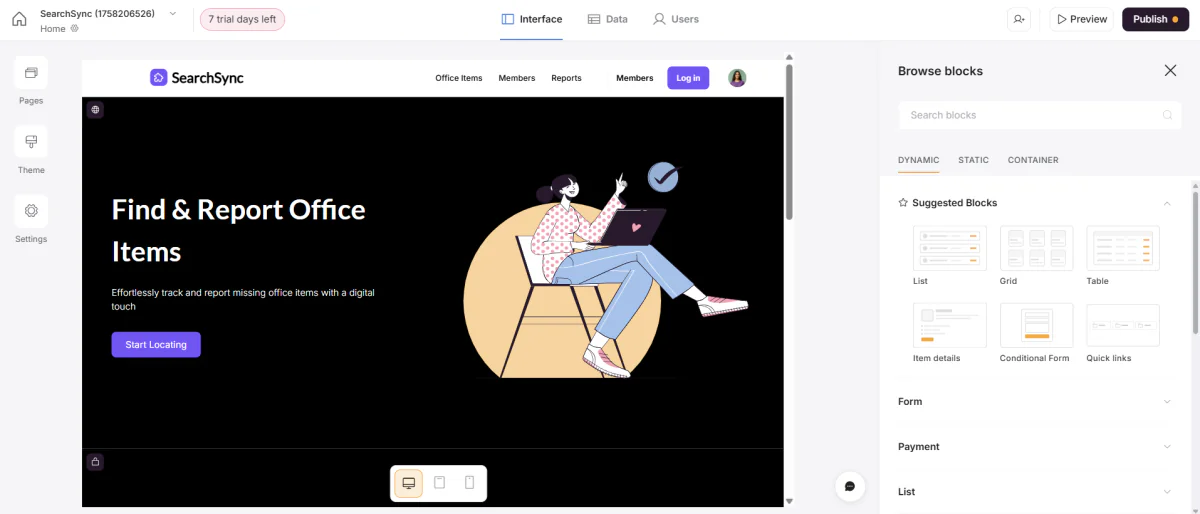
A few seconds later, I was taken to the Softr editor.
I was pleased with how my app turned out. It looked professional, structured, and easy to navigate.
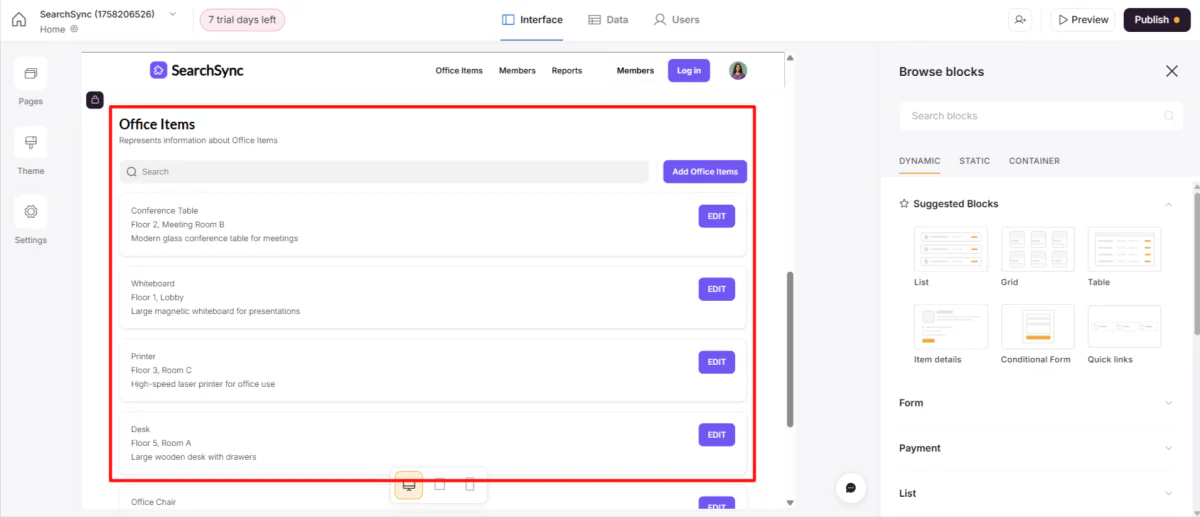
It also included the features I wanted, like a bulletin board for members to report or locate misplaced office items.
Step 5: Add Blocks
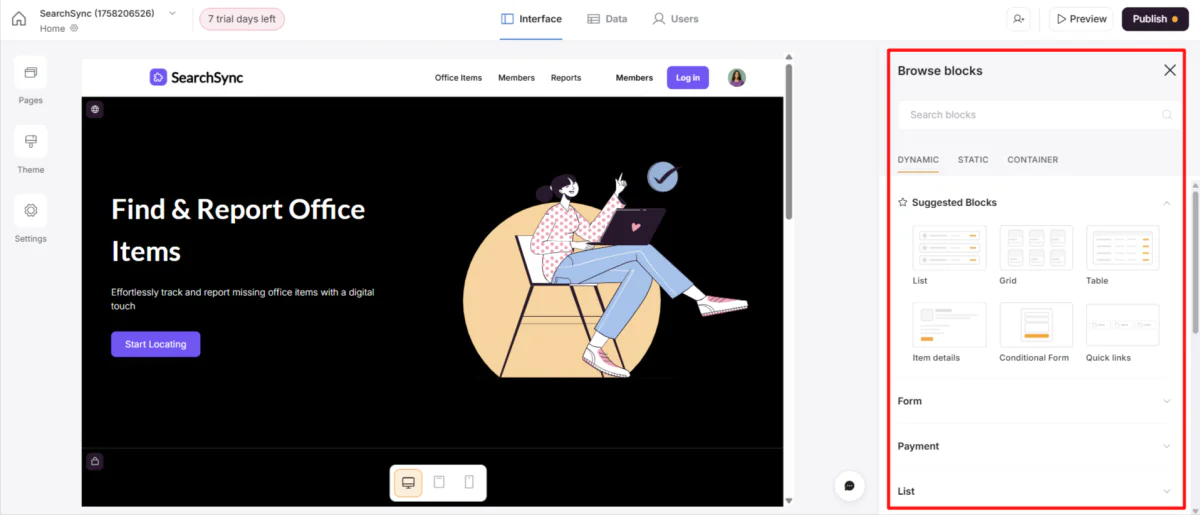
What I love most about Softr is that instead of coding everything from scratch, it uses a simple block-based system. You’re essentially playing with pre-built blocks (kind of like digital Legos). These blocks can be accessed in the right panel.
You’ve got list blocks for displaying data, form blocks for collecting information, chart blocks for analytics, and detail blocks for individual records.
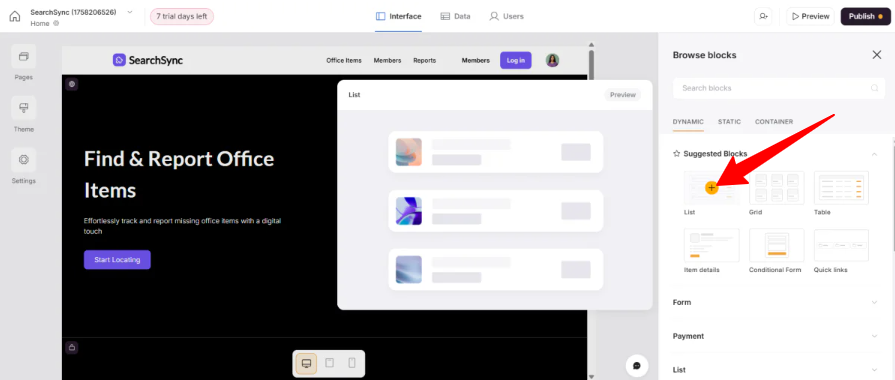
Adding blocks to my app was as simple as hovering my mouse over the block I wanted to add and hitting the “+.”
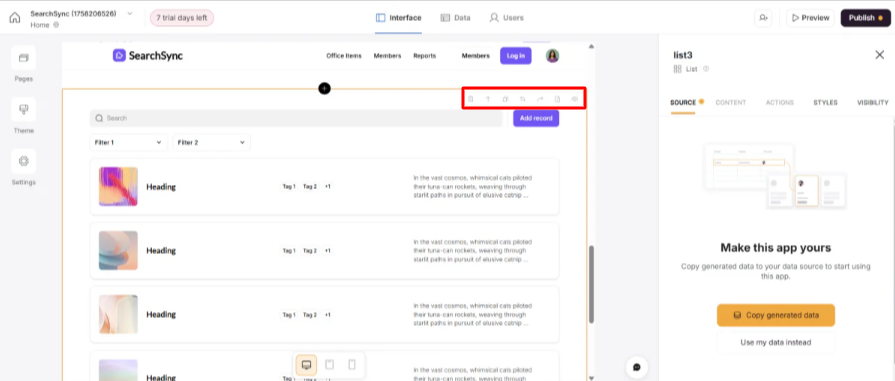
With a single click, I added a list block to my app. Hovering over it in the preview revealed some customization options:
- Delete
- Move up
- Duplicate
- Change block type
- Copy to
- Notes
- Hide
Step 6: Connect Data
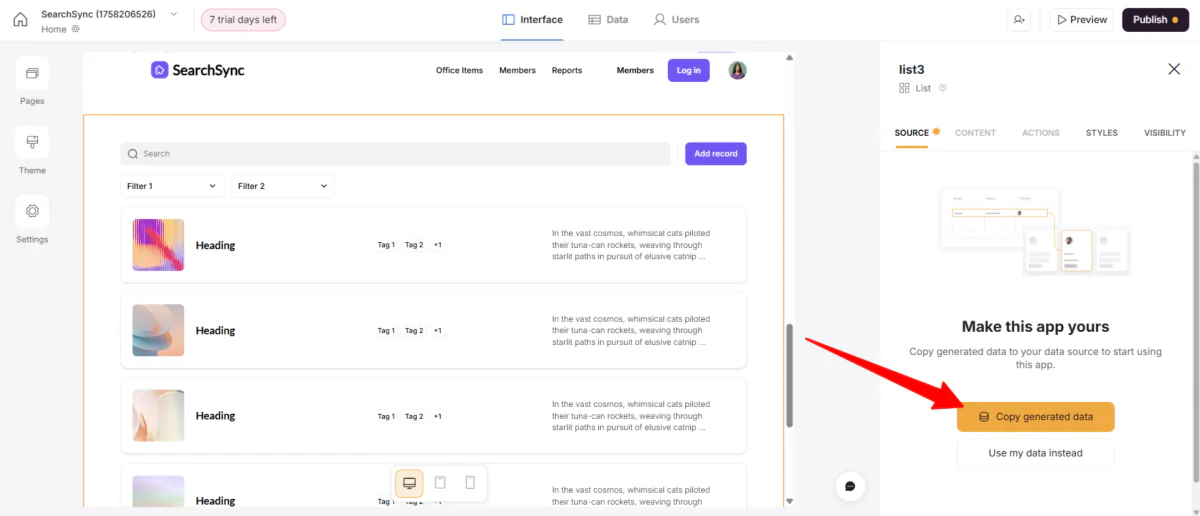
In the right panel, I could change the styles, visibility, and add data to my app to start using it. I could either copy the generated data or use my data instead.
Copying the generated data meant Softr would provide me with the data needed. Meanwhile, “Use my data instead” meant connecting my own existing data rather than copied template data.
I selected “Copy generated data.”
Step 7: Choose the Data Source
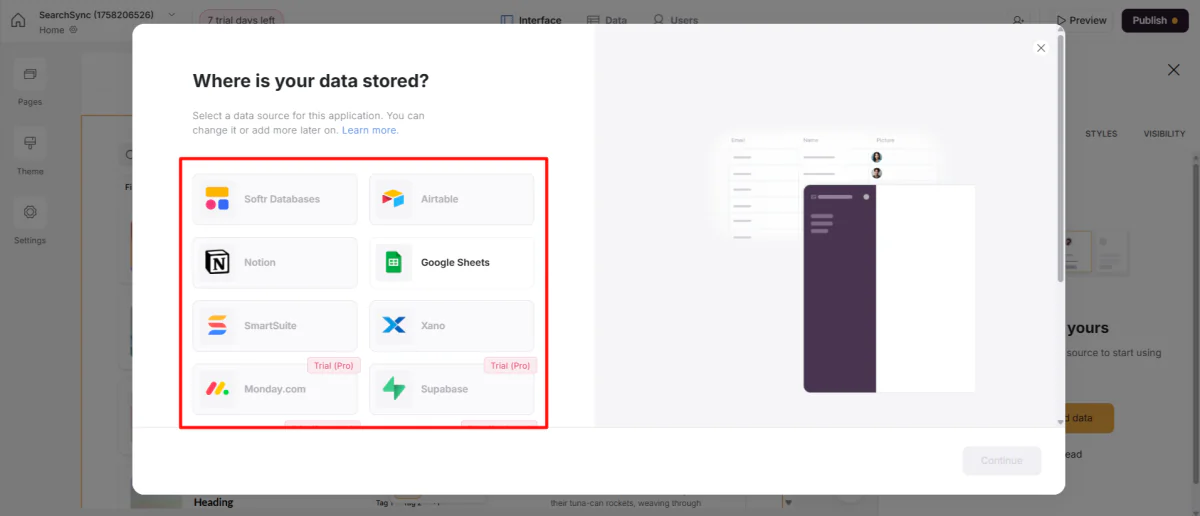
Next, Softr asked where my data was stored. These data sources included Notion, Google Sheets, Airtable, etc.
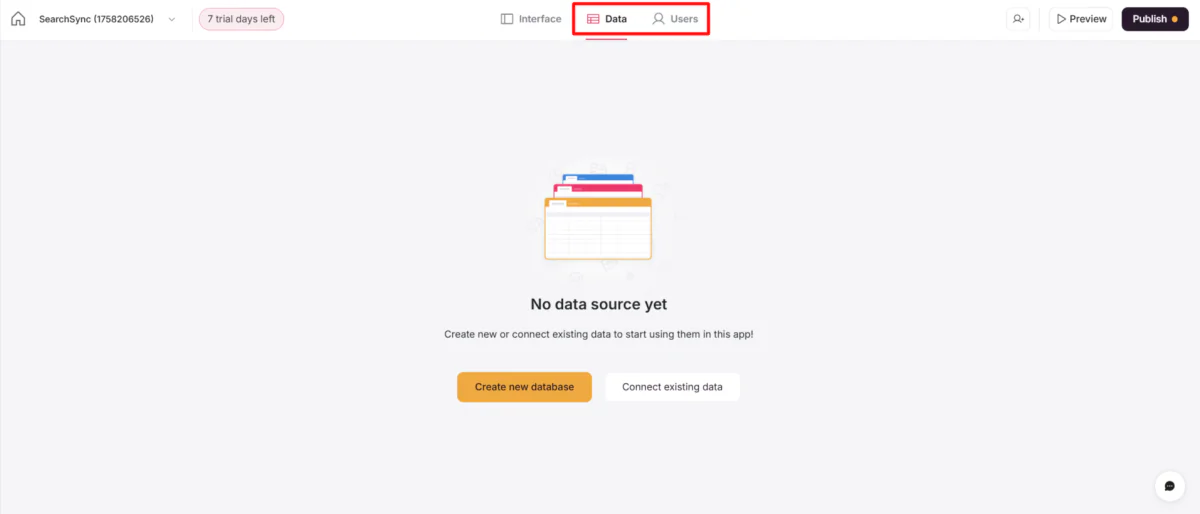
At the top, I could also add data sources and users with different permission levels.
Step 8: Add Pages & Adjust the Theme
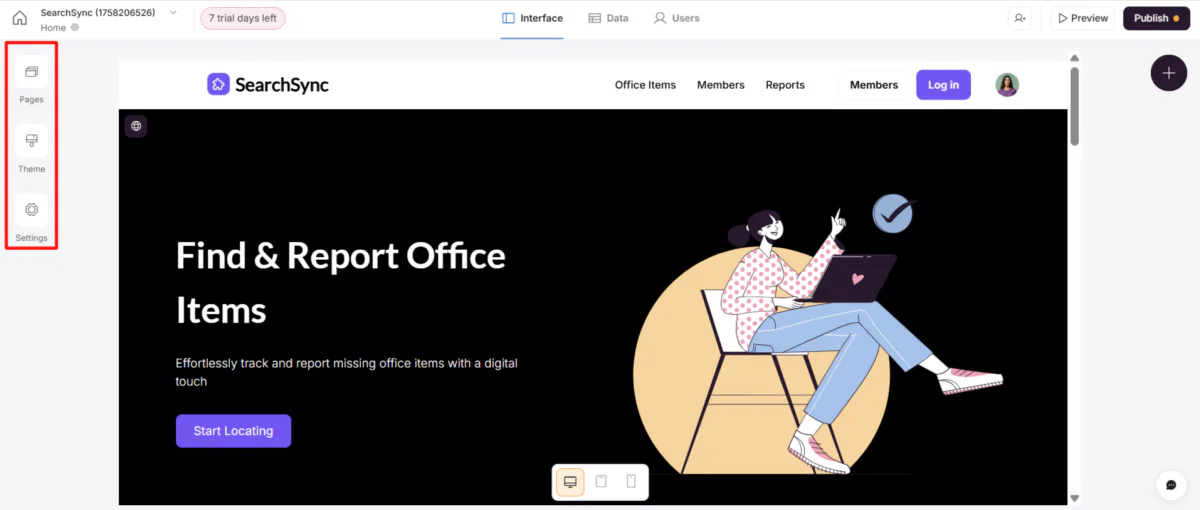
Back in the interface, I could add pages and adjust my theme and settings on the left.
Step 9: Preview the App
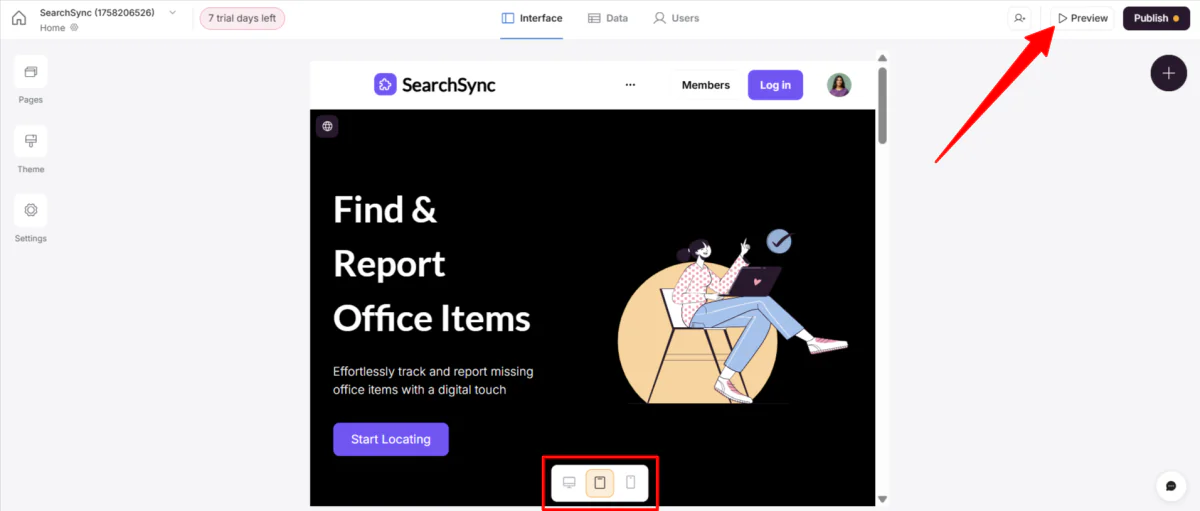
Once I was happy with the blocks and design, I always make sure to test my app on mobile before publishing. Softr does a decent job with responsive design, but some blocks can get wonky on smaller screens.
The easiest way to test my app was to select the different devices at the bottom of the preview. Otherwise, I could hit the “Preview” button on the top right to get a full-screen preview.
Step 10: Publish
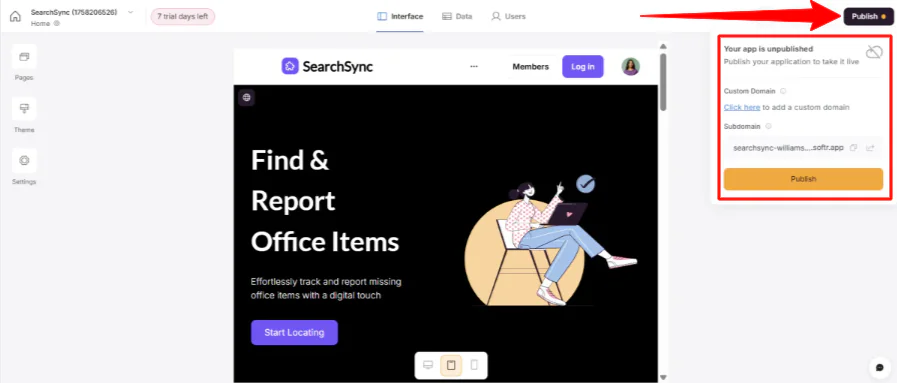
Once I was satisfied, I clicked “Publish” at the top right. This made my app publicly accessible online. I could publish my app on the subdomain provided by Softr or add a custom domain.
Overall, Softr made it easy for me to go from an idea to a working app in minutes. The process felt effortless, and I was impressed by how professional my app looked.
Top 3 Softr Alternatives
Here are the best Softr alternatives I’d recommend:
Base44
The first Softr alternative I’d recommend is Base44. It’s a no-code AI platform that enables you to build full apps quickly with natural language prompts. It creates the backend (databases and logic) and provides a visual editor for designing the front end.
Base44 is a backend-first platform that automatically creates data infrastructure. From there, you can either let Base44’s chatbot update the app for you or make your own visual edits right inside the live app preview.
Meanwhile, Softr is great for building business apps with secure logins, role-based access, and smooth integration with tools like Airtable, Google Sheets, Notion, and HubSpot. Like Base44, its AI app generator quickly creates apps from short prompts.
Choose Base44 for fast AI app creation with built-in backend and automation. Otherwise, choose Softr for secure, scalable business apps with roles and plenty of integrations.
Read my Base44 review or visit Base44!
Draftbit
The next Softr alternative I’d recommend is Draftbit. With it, you can visually build and customize mobile apps with clean, production-ready code you can use anywhere.
Draftbit stands out by giving full control. You can export your app’s code, add custom React Native components, and connect directly with APIs.
Meanwhile, Softr stands out for quick prototyping of internal tools, membership sites, and B2B portals. It also comes with 90+ templates and built-in SEO.
Choose Draftbit to create mobile apps with full code control. Otherwise, choose Softr to quickly create web apps, dashboards, and portals with database connections.
AppMySite
The final Softr alternative I’d recommend is AppMySite. It’s a no-code platform that turns your website into a mobile app. AppMySite makes it easy for businesses to enter the app market without developers.
On the one hand, AppMySite is more focused than Softr. It provides website syncing, customizable app designs, and app store publishing to the Google Play Store and Apple App Store.
Meanwhile, Softr effortlessly builds directories, membership sites, and client dashboards with its drag-and-drop design and built-in SEO for better visibility.
Build internal tools or client portals effortlessly with Softr. Otherwise, use AppMySite to quickly launch mobile apps with smooth app store integration and modern designs.
Softr Review: The Right Tool For You?
Overall, Softr made building a functional, professional-looking app surprisingly easy. From giving it a simple prompt to connecting my own data, the process felt fast and intuitive.
I loved how the block-based editor let me piece together complex workflows without writing a single line of code. However, these blocks made customization feel limiting.
Nonetheless, Softr hit the sweet spot for me. It’s powerful enough for real business applications yet simple enough to keep the process enjoyable.
If you want to quickly create client portals, internal tools, or membership sites without coding, Softr is an excellent choice. Otherwise, consider these alternatives:
- Base44 is best for quickly generating apps with automated backends and visual data control.
- Draftbit is best for full control over mobile apps with exportable code.
- AppMySite is best for quickly turning a website into a mobile app.
Thanks for reading my Softr review! I hope you found it helpful.
Softr offers a plan where you can publish a single app for free. Try it for yourself and see how you like it!
Frequently Asked Questions
Is Bubble better than Softr?
Is Softr good for beginners?
Yes, Softr is great for beginners. Its drag-and-drop editor, templates, and Airtable/Google Sheets integrations let anyone build web apps quickly without coding.
What is the difference between Softr and Airtable?
The main difference between Airtable and Softr is that Airtable is a database tool for organizing and managing data, while Softr turns that data into functional apps.
How does Softr compare to other website builders?
Softr stands out by letting you build powerful apps and client portals without coding. It easily connects to Airtable, Google Sheets, and other databases. Unlike Wix or Webflow, it provides strong security, ready-made blocks, and user permissions. It’s great for businesses building custom workflows and internal tools.
Is Softr completely free?
Softr isn’t fully free, but its free plan includes one app you can publish, 10 app users, 2 user groups, and 5,000 Softr Database records. For more features and flexibility, you’ll need to upgrade to a paid plan.
What is the use of Softr?
Softr quickly builds no-code apps like internal tools, client portals, and membership sites. It turns data from spreadsheets or databases into functional apps with its drag-and-drop interface and integrations.













